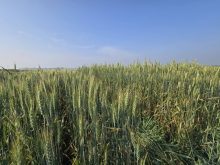Warming temperatures last week through the U. S. Plains were driving emergence of what looks to be a hardy new U. S. winter wheat crop, although agronomists were worried that wet weather could delay fertilizer applications and lower yields.
Overly wet fields were limiting farmer efforts to fertilize their wheat, and experts said the window for doing so was rapidly closing. The wet fields are also the perfect breeding ground for fungal diseases such as stripe rust.
The condition of this year’s winter wheat crop is being closely watched as plantings this season were pegged at 37.097 million acres, the lowest in 97 years.
Read Also

The long march to autonomy
The big players in the machinery market keep adding pieces towards autonomous vehicles for farming, but how far away is a final product?
Ample soil moisture, due to heavy winter snowfall and persistent recent rains, should aid the wheat’s overall development as moisture is key to good growth. Still, the ground needs to dry out a bit to facilitate more advantageous growing conditions, agronomists said.
“It is kind of a trade-off,” said Oklahoma State University small grains specialist Jeff Edwards. “I don’t think it will have full yield potential.”
More rain was forecast over the next few days through the Plains, but temperatures were finally on the rise, climbing above 70F (21C), after an extended cold winter.
Updated reports issued Mar. 8 showed the crop in top U. S. wheat producer Kansas rated 60 per cent good to excellent, up from 53 per cent a week earlier. Twenty per cent of the winter wheat was breaking dormancy, a rapid jump compared with four per cent the previous week.
“Wheat will really take off now,” said Kansas State University agronomist Jim Shroyer.
Still, Shroyer said he saw the potential for yield problems due to a lack of fertilizer application, and a abundance of late-planted wheat in south-central Kansas, typically a top production area.
To the south in Oklahoma, the new wheat crop was rated eight per cent excellent and 57 per cent good as of Mar. 7 by the state’s agricultural statistics service.
And in Texas, the wheat crop was rated nine per cent excellent and 36 per cent in good shape. Some fields were reported standing in water, however.
“We’re wet all over the state of Texas,” said Texas A&M agronomist Travis Miller.
Miller said reports of stripe rust were noted in Louisiana due to cool and wet conditions and he feared disease might spread.
“Overall I think we’re going to have a good start on the wheat crop,” Miller said.














